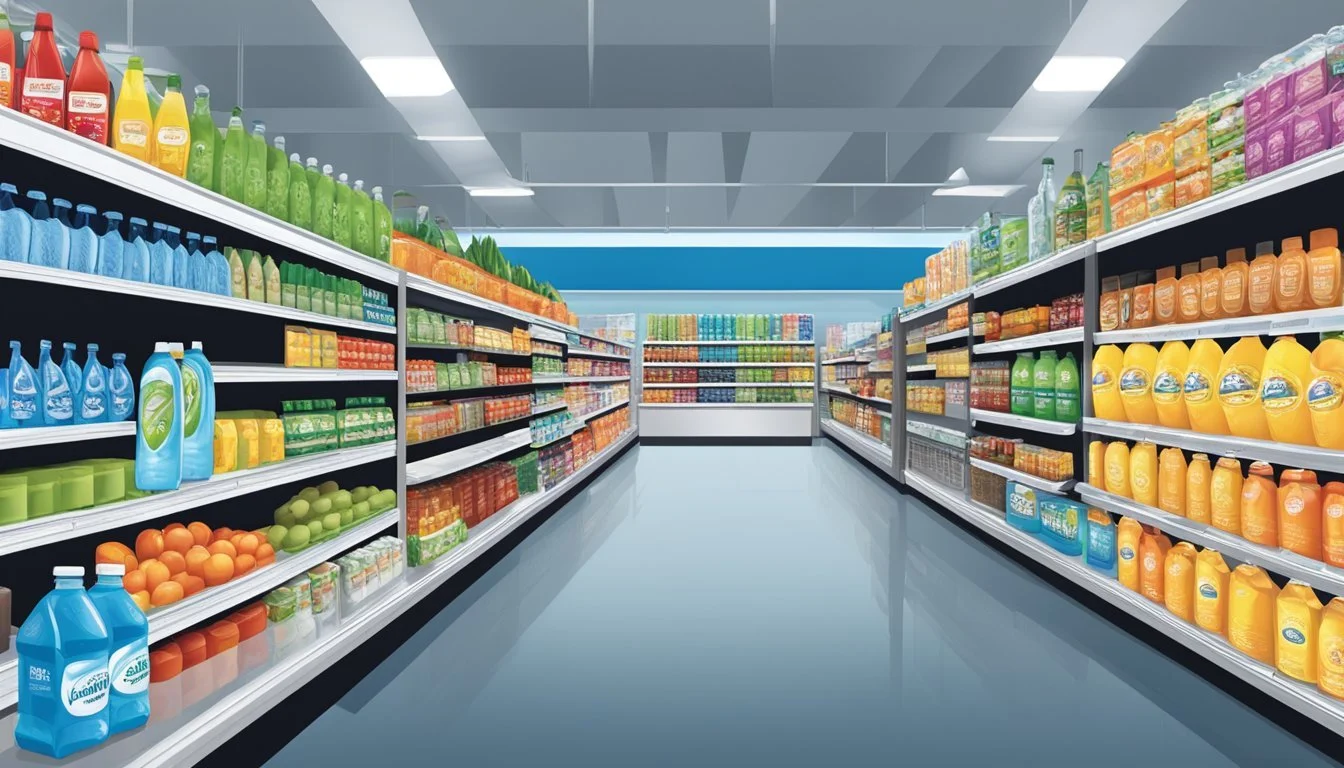Castle Rock vs. The Well
Comprehensive Comparison of Bottled Water Brands
Water quality is a critical concern for consumers making choices about their health and hydration. Bottled water from brands like Castle Rock and The Well often presents itself as a step above ordinary tap water. With the bottled water industry growing rapidly, the range of options can seem overwhelming.
Castle Rock water is sourced from natural springs, promising pure and refreshing taste. In contrast, The Well ensures reliable quality control and consistent taste, factors consumers often look for in their choice of drinking water. For those balancing quality and taste, The Well might be the better option.
Given the appeal of tap water for its cost-effectiveness and environmental benefits, bottled water continues to offer convenience and perceived quality. The decision between Castle Rock and The Well ultimately depends on personal preferences and priorities.
Understanding Bottled Water
Bottled water comes in various types, each with unique characteristics, origins, and health benefits. It's essential to understand these differences, the bottling processes involved, and the regulations ensuring its safety.
Types of Bottled Water
There are several types of bottled water available.
Spring water is sourced from underground aquifers and naturally rises to the surface.
Mineral water contains naturally occurring minerals and must come from a protected, legal source.
Sparkling water is carbonated, either naturally or artificially, providing a fizzy texture.
Purified water, such as reverse osmosis and distillation, undergoes rigorous filtration to remove impurities.
Other varieties include artesian water, sourced from deep bedrock wells with high mineral content, and club soda, which is carbonated and infused with minerals.
Bottling Processes
The bottling process for water involves several critical steps to ensure purity and safety.
Source extraction: Where the water is sourced, whether from springs, wells, or municipal supplies, determines its initial quality.
Filtration and purification: Steps like reverse osmosis and carbon filtration remove contaminants and unwanted substances.
Mineral addition: In some cases, essential minerals are added to enhance taste and health benefits.
Bottling: The final step includes bottling the purified or treated water in various containers, such as glass or plastic. Glass is often preferred for its environmental benefits.
Regulations and Safety
Several regulatory bodies oversee bottled water to ensure it is safe for consumption.
FDA regulations: In the United States, the FDA sets standards for bottled water quality, including limits on contaminants and labeling requirements.
Inspection and testing: Bottled water companies must regularly conduct water quality tests to ensure compliance with safety standards.
Label transparency: Labels must accurately reflect the water's source, contents, and any treatments it has undergone.
International standards: Different countries have their own regulations, often similar to those in the United States, demonstrating a global commitment to water safety.
Understanding these aspects will help consumers make informed choices about the bottled water they purchase and consume.
Comparing the Sources
Castle Rock offers natural spring water, while The Well's water originates from well sources. Understanding the distinctions between these sources provides insight into the quality and reliability of each water supply.
Castle Rock's Natural Spring Water
Castle Rock’s natural spring water derives from a pristine spring located in Castle Rock, providing a pure and reliable water source. Natural spring water is collected directly from the spring, known for its consistent mineral content and refreshing taste.
Castle Rock Water Company ensures that the spring water undergoes minimal processing to maintain its natural characteristics. This process helps preserve the water's original mineral balance, contributing to its clean and refreshing profile.
Additionally, natural spring water's reputation for being less likely to contain contaminants, owing to the controlled environment of the spring, makes it an appealing choice for consumers seeking purity and natural taste.
The Well's Well Water Origins
The Well sources its water from private wells, tapping into underground groundwater reserves. Typically, well water is drawn from aquifers, which are underground layers of water-bearing rock or sediment. This type of water source often reflects the geological characteristics of its location.
Well water can vary in mineral content, depending on the surrounding geological materials. Regular monitoring and maintenance are crucial to preventing contamination from surface pollutants or agricultural runoff.
Consumers of well water benefit from a potentially rich mineral profile, but must also be vigilant about testing and treatments to ensure its safety and quality. artesian wells, which are pressurized aquifers, may also contribute to well water supplies, providing another layer of natural filtration.
The Brand Perspective
Castle Rock and The Well offer distinct perspectives on market presence, sustainability efforts, and consumer perception.
Market Presence and Reputation
Castle Rock and The Well both compete in the crowded bottled water market. Castle Rock is renowned for its crisp spring water, appealing to consumers who prefer a taste likened to a fresh morning hike. Meanwhile, The Well commands recognition for its premium positioning, often compared to other high-end brands like Voss and Evian. In terms of public exposure, Castle Rock has a more local yet loyal customer base, whereas The Well enjoys a broader, perhaps more international, following.
Sustainability Efforts
The sustainability practices of these brands differ, reflecting their unique ethos. Castle Rock emphasizes eco-friendly initiatives, opting for environmentally friendly packaging, including glass bottles, to reduce plastic waste. The Well, while also committed to sustainability, focuses on reducing carbon emissions across its supply chain, aligning with efforts seen in brands like Icelandic Glacial and Essentia. Both companies underscore the importance of sustainability to their brands but approach it with varied strategies.
Consumer Perception
Consumers view Castle Rock and The Well through distinct lenses. Castle Rock garners appreciation for its pure, refreshing taste, consistent with a preference for natural spring water. This perception is similar to the consumer loyalty experienced by brands like Fiji and Evian. Conversely, The Well is perceived as a luxury option, often linked with Smartwater and Core Hydration for its high purity and sophisticated branding. Both brands succeed in attracting their target audiences but do so by cultivating specific, nuanced brand experiences.
Understanding Water Quality and Benefits
When comparing Castle Rock well water to bottled water, it is crucial to assess the mineral content and health benefits, as well as the quality reports and standards that ensure safe drinking water.
Mineral Content and Health Benefits
Castle Rock well water often contains minerals such as iron and sodium, which can provide health benefits. Iron is essential for transporting oxygen in the blood, while sodium helps with nerve and muscle function.
Bottled water may also offer these minerals, but levels can vary significantly between brands. Some bottled waters are fortified with fluoride, which supports dental health. However, the source of the water can impact whether these minerals are naturally occurring or added during processing.
Water Quality Reports and Standards
Castle Rock ensures that well water meets strict standards for safe drinking water. Monitoring includes testing for contaminants like bacteria to ensure quality. These efforts have earned the town multiple excellence awards for the engineering and efficiency of the Plum Creek Water Purification Facility.
In comparison, bottled water companies are mandated to meet state and federal regulations. Their quality reports provide transparency about water quality, outlining the presence of minerals and any possible contaminants. Consumers can check these reports to verify the safety of their bottled water, giving them peace of mind regarding the quality of their drinking water.
Economic and Environmental Impacts
Understanding the economic viability and environmental consequences of bottled water brands like Castle Rock and The Well is crucial for informed choices. Key factors include the cost differences and the environmental footprint, including packaging and carbon emissions.
Cost Factor: Inexpensive vs. Expensive Water
Castle Rock and The Well vary significantly in pricing. Castle Rock generally falls on the higher end of the price spectrum, similar to brands like San Pellegrino and LifeWtr. It targets a niche market that values eco-conscious products and premium quality.
In contrast, The Well is positioned more affordably, comparable to Poland Spring and Deer Park. This makes it accessible for everyday consumption. The cost factor directly impacts consumer choices, especially in regions like North America and Canada where price sensitivity can be high.
It is important to weigh the benefits of inexpensive options against the unique selling points of expensive water, including potential health benefits and perceived quality.
Environmental Considerations and Packaging
Environmental impact remains a critical issue. Castle Rock prides itself on using eco-friendly packaging, including boxed water options and reusable bottles, which helps minimize waste. Their production process aims to reduce CO2 emissions, aligning with sustainability goals.
The Well, while more affordable, often uses PET containers that, though recyclable, contribute significantly to CO2 emissions, estimated between 1.6 and 22 oz per 50 oz of bottled water produced. Compared to tap water, bottled water like The Well’s has a carbon footprint up to 3500 times greater, raising environmental concerns.
Consumers seeking environmentally responsible choices should consider the type of packaging and the overall environmental impact of their bottled water brands.
Consumer Accessibility and Convenience
Both Castle Rock and The Well offer unique advantages in terms of consumer accessibility and convenience. This section delves into their availability in retail spaces and how they cater to the needs of the modern consumer.
Availability and Retail Distribution
Castle Rock and The Well are both highly accessible through various retail channels. Castle Rock water is widely distributed in major supermarkets, health food stores, and specialized water boutiques. This broad presence ensures that consumers can easily find Castle Rock water whether they are grocery shopping or visiting specialized stores.
The Well, on the other hand, has a robust distribution network that not only covers physical stores but also emphasizes online availability. Their partnership with prominent online retailers and their own direct-to-consumer website ensures that consumers can purchase their products effortlessly from the comfort of their homes. This extensive online presence is complemented by email newsletters that keep consumers informed about new products and promotions.
Convenience for the Modern Consumer
Modern consumers value convenience and flexibility, and both brands have designed their offerings to meet these needs. Castle Rock provides a variety of bottle sizes, from personal-sized bottles to larger family packs, catering to different consumption patterns and preferences. Their packaging is environmentally friendly, using 100% recyclable materials, which appeals to eco-conscious consumers.
The Well also prioritizes convenience by offering subscription services through their website, allowing customers to receive regular deliveries without the hassle of reordering. Additionally, their mobile app provides another layer of convenience, enabling users to manage orders, track deliveries, and access special deals with ease.
Both brands understand the importance of catering to busy lifestyles, making their products easily accessible and convenient for a diverse consumer base.
The Bottom Line
When deciding between Castle Rock Bottled Water and well water in Colorado, several factors come into play. Well water must be diligently maintained to avoid potential contaminants. Regular testing is needed to ensure its safety. Homeowners often employ pumps to access their well water, making it a self-sustained option.
Castle Rock Water offers a different advantage. Their water, sourced from the springs of Mount Shasta, goes through natural purification. The FDA regulates bottled water, providing an added layer of confidence in its safety.
Packaging is another consideration. Castle Rock uses environmentally friendly glass bottles. These bottles range from 1-litre to 5-gallon jugs, offering versatility in usage. Comparatively, Acqua Panna, another reputable brand, also emphasizes quality and eco-friendly packaging, like Castle Rock.
Price can vary. For instance, Castle Rock bottled water costs $2.99 per bottle. This can add up for families, whereas well water might only involve periodic maintenance costs.
In essence, the choice depends on personal priorities, whether it's the convenience and assured quality of Castle Rock or the autonomy and long-term cost-effectiveness of well water.






